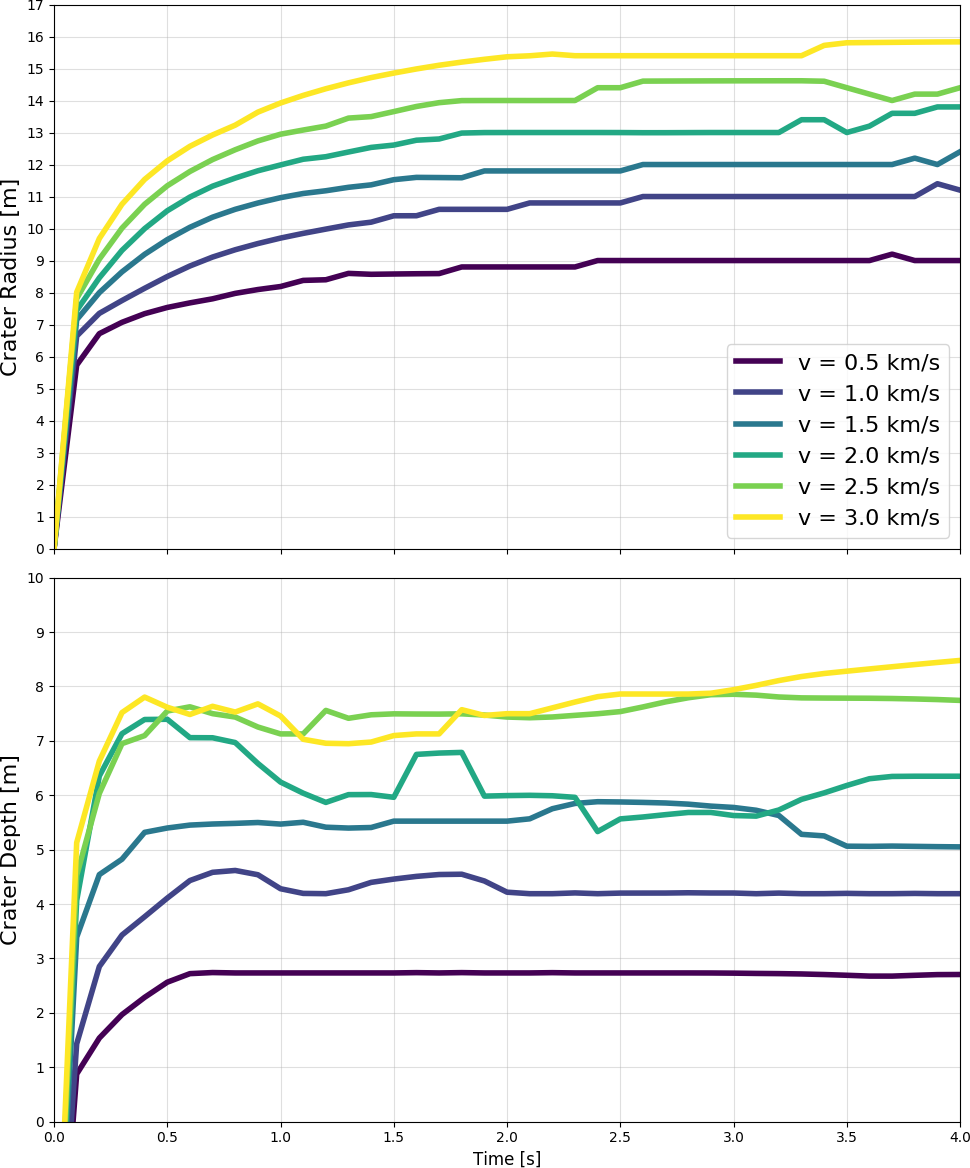From Debris to Resource: Simulating High-Velocity Impacts of Space Debris on the Moon
- 1Institut für Luft- und Raumfahrttechnik, Technische Universität Berlin, Germany
- 2Museum für Naturkunde - Leipniz Institute for Evolution and Biodiversity Science, Berlin, Germany
- 3Freie Universität Berlin, Germany
- 4Orbit Recycling, Hauneck, Germany
1. Introduction
The quantity of space debris—defunct human-made objects in orbit—continues to increase, including old satellites, spent rocket stages, and fragments resulting from disintegration, erosion, and collisions. Space debris poses a significant risk for space travel and satellite operations, as even small pieces, traveling at high velocities, can cause substantial damage or destruction upon colliding with satellites or spacecraft. This growing accumulation increases the risk of collisions, poten tially triggering a cascade effect known as the Kessler Syndrome, which could render certain orbits unusable for future satellites.
Despite the impending threat to space infrastructure, measures to mitigate space debris are insufficiently implemented, primarily due to high associated costs. Furthermore, existing regulations are often more akin to recommendations than mandatory directives. A solution with potential economic benefit is to collect larger objects (e.g. a Ariane 5 upper stage in the geostationary transfer orbit), and to transport this material to the lunar surface, where the metal can be used in future projects [1]. To facilitate recycling, the debris is planned to impact the Moon at velocities ranging from 0.5 − 3.0 km/s. Upon impact, the debris would break down, and the resulting fragments would be collected by moon rovers. In this study, we analyze the effect of impact velocity and target parameters on the fate of the projectile and the resulting crater, using numerical simulations.
2. Methods
In this study, we apply iSALE-2D shock physics code [2-4] to simulate the impact of an Ariane 5 ESC-A upper stage (4540 kg, 5.4 m in diameter, 4.711 m in height [5]) onto lunar regolith at velocities from 0.5 − 3 km/s. A realistic representation with thin walls is computationally expensive as it requires a large model resolution. Here, we consider four representations of the projectile: We represent the Ariane upper stage as 1) a small homogeneous cylinder with the density of aluminum alloy 2219 (ρ=2840 kg/m³), 2) a porous cylinder of the same mass, and a correct volume of the projectile, using the epsilon-alpha porosity compaction model [4], 3) a homogeneous cylinder of the same mass and volume but instead of using the porosity model, we modify the density specified in the equation of state, and 4) a hollow cylinder with resolved walls and end caps. We use a grid spacing of 0.2 and a resolution of 14 cells per projectile radius in vertical and horizontal direction.
The projectile and target are simulated by a Tillotson equations of state [6]. It is designed for high-velocity impact computations and hence capable of handling the relevant pressure ranges for this study. A granular behavior is assumed for the regolith target. Therefore the Drucker-Prager strength model with the strength Y=min(Y0+μp,Ym) is used, where Y0 is the cohesion (yield strength at zero pressure), μ is the coefficient of internal friction for material, Ym is the limiting strength at high pressure and p is pressure. The parameters for the regolith are taken from [7], including porosity model parameters. We apply the Von Mises strength model for the aluminum of the upper stage: Y=Y0. For the porous projectile representation, we derive an elastic threshold based on the Youngs modulus and the yield strength as: ε=315 MPa / 73 GPa=0.004. Both values for this equation are taken from [8].
3. Results
Here, we show results generated using a porous projectile. We observe, as expected, that with increasing kinetic energy, the radius and depth of the crater increase as well (Figure 1). For the slowest impact of 0.5 km/s, the crater grows to ∼ 18 m in diameter, while it reaches ∼ 32 m for an impact at 3 km/s. The faster impact also generates a more heterogeneous pressure distribution (Figure 2).
We find that in the case of the slower impact, the resulting crater is relatively shallow (Figure 2 top panel), with a depth-diameter ratio of 0.17, while it reaches 0.25 for the fastest impact (Figure 2 bottom panel).

Figure 1: Simulated crater radii and depths from the instant of impact until 4 seconds after impact.

(2a) Impact velocity vimpact = 0.5 km/s .

(2b) Impact velocity vimpact = 3.0 km/s .
Figure 2: Crater snapshot at 4 seconds after impact. The pressure and density are plotted on the left and right halves, respectively.
4. Discussion & Conclusion
The plotted depth in Figure 1 (lower panel) occasionally deviates from the final value, which is likely due to numerical artefacts or residual material close to the symmetry axis. An adjustment of the analysis procedure can reduce this noise.
The study investigates lunar surface recycling of space debris, specifically through the high-velocity impact simulation of an Ariane 5 upper stage on lunar regolith. The method's potential in repurposing space debris for lunar construction is promising, contributing to sustainable lunar exploration efforts. However, anomalies in pressure distribution and crater rim identification suggest simulation refinement.
References
[1] F. Koch. 8th European Conference on Space Debris, 8(1), 2021.
[2] A.A. Amsden, H.M. Ruppel, and C.W. Hirt. Technical Report LA-8095, 5176006, June 1980.
[3] G.S. Collins, H.J. Melosh, and B.A. Ivanov. Meteoritics & Planetary Science, 39(2):217–231, February 2004.
[4] K. Wünnemann, G.S. Collins, and H.J. Melosh. Icarus, 180(2):514–527, February 2006.
[5] R.Lagier et al. User’s Manual, (1), 2021.
[6] J. H. Tillotson. Technical report, July 1962.
[7] R. Luther et al. The Planetary Science Journal, 3(10):227, October 2022.
[8] C.Y. Ho, J.M. Holt, and H. Mindlin. Number Bd. 2. Cindas/Purdue Univ., 1997.
How to cite: Langer, N., Luther, R., Wünnemann, K., Koch, F., and Linke, S.: From Debris to Resource: Simulating High-Velocity Impacts of Space Debris on the Moon, Europlanet Science Congress 2024, Berlin, Germany, 8–13 Sep 2024, EPSC2024-956, https://doi.org/10.5194/epsc2024-956, 2024.